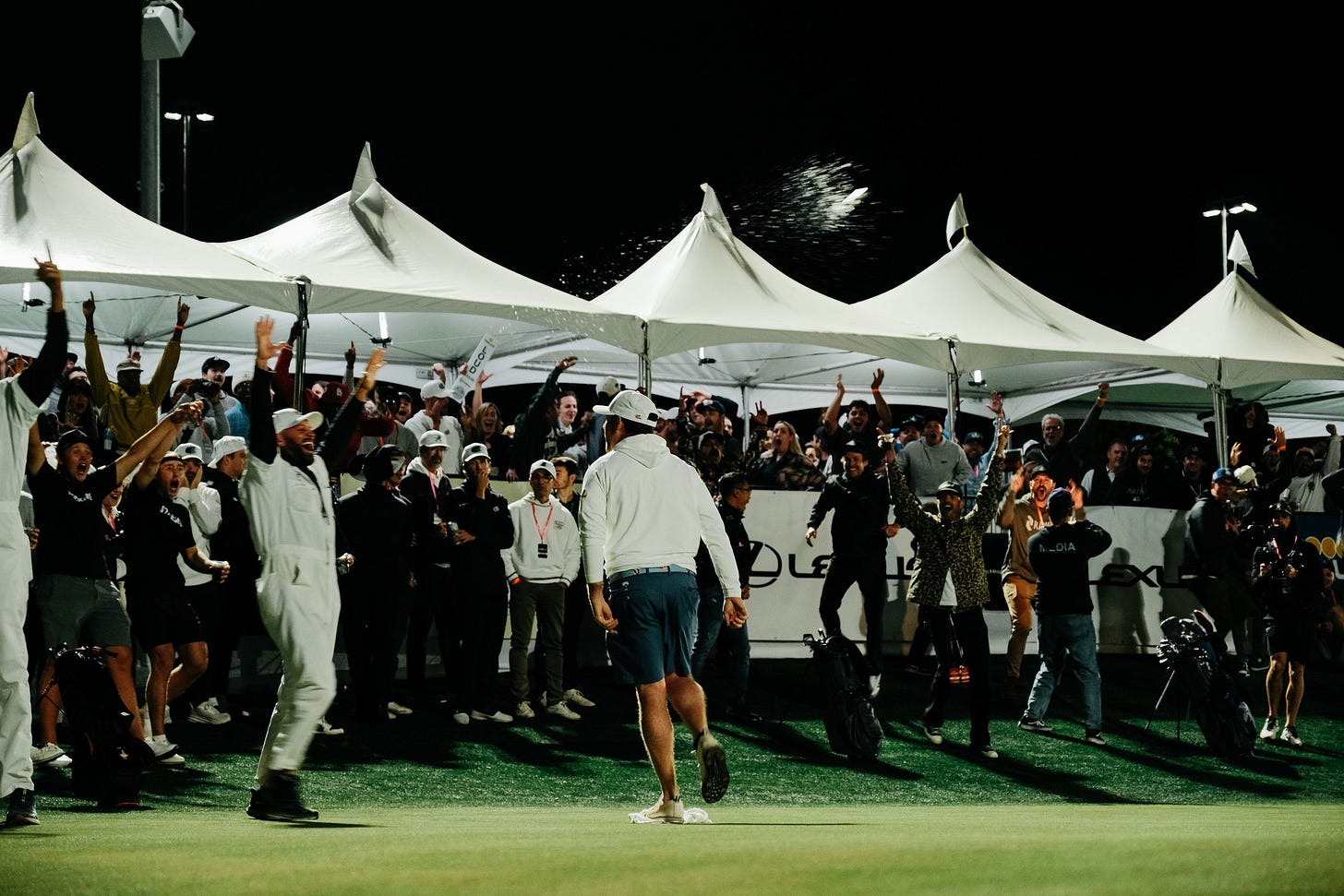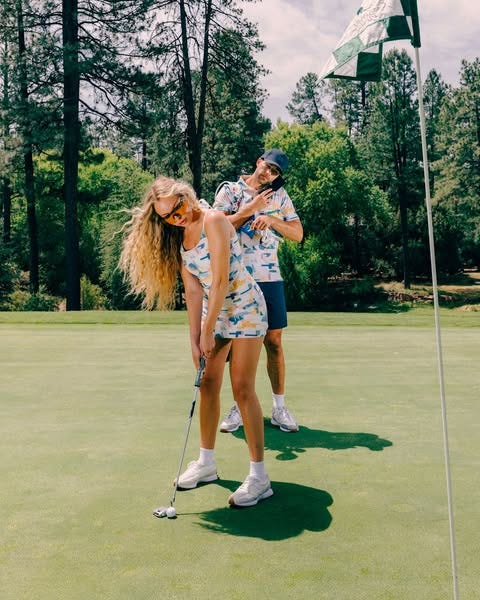Why Grass League Might Be Golf’s Best Kept Secret
How a fast-paced, team-based par-3 tour is reshaping golf culture — under the lights, on social, and with something real to say.
The best shot in golf isn’t the one that flies 350 yards. It’s the wedge that checks and spins back to within tap-in range. That’s where the magic lives, and it’s also where the Grass League is building its entire identity: from 150 yards and in.
This isn’t country club tradition. This is night golf under the lights in Tempe, Arizona. Teams with names like the San Diego Munis and Tampa Bay Swamp Dawgs. Two-player scrambles. Fast rounds. Big personalities. Paige Spiranac’s doing social coverage like it’s a music festival. And Sedona Hopley, a longtime Grass League supporter, shared her insider view with me to help us understand what makes this tour so special.
With its second season underway, the Grass League isn’t trying to imitate the PGA Tour. It’s not a protest movement like LIV either. It’s something different. Something that’s quietly carving out space in golf’s crowded ecosystem, and if the early signals are anything to go by, it’s a model that might just have staying power.
The 2025 season opened with the Grass Clippings Open at Rolling Hills in Tempe, airing live on Peacock and played under the lights. It wasn’t just the start of another tournament, it was a statement of intent.
Shorter rounds. Prime-time viewing. A par-3 format that rewards shot-making, not just power. And teams that fans can root for. Not players. Teams. Team names based on locations, and that works, because it helps build tribalism among fans. Something another league didn’t quite get right, in my opinion.
The tour, founded in 2018 and officially launched into a full season format last year, features 11 franchises with names and branding that feel closer to minor league baseball than traditional golf. The Dallas team includes members of Good Good Golf, a popular YouTube collective with millions of followers and a strong Gen Z fanbase. The format is a two-player scramble, designed to be fast, entertaining, and inclusive.
And it’s working. The opening event in Arizona pulled attention across golf’s digital circles, not for birdie streaks or final-round comebacks, but for the vibe. The social energy. The access.
Sedona Hopley, an Arizona golf personality affiliated with the home team, PHX United, put it like this: “Par-3 competitive golf, fantastic food, unreal vibes and live music? Affordable tickets too. Oh and also under the lights!? Even if you aren’t a fan of golf, there’s no way you could have a bad experience attending a Grass League event.”
Follow me for more sports and life updates: Instagram
At its core, the Grass League is built on the idea that golf, real, competitive golf, can be reimagined without losing its soul. The founders don’t claim it’s better than the PGA Tour. But they believe it’s different and that difference could be key to future growth.
Jake Hoselton, the league’s CEO, put it plainly in a recent interview with Golf.com:
“Par-3 golf is a standalone sport. It’s quicker, it’s more action-packed, but it’s still golf.”
That isn’t just a format pitch — it’s a philosophical stance. Traditional golf is time-consuming and hard to access, especially for younger or casual fans. Par-3 courses are shorter, more affordable, and easier to broadcast in full. Add team-based competition and night play, and it starts to feel like a proper entertainment product.
Hoselton added:
“Par-3 golf, and particularly the format that we use — the two-person scramble — lends itself the ability to have men and women ages 18 to 75 who are competitive. It levels the playing field. And all of golf’s greatest moments happen from 150 yards and in.”
That might sound like marketing, but it’s also not wrong.
“Playing from distances where co-ed is fair, it’s really anyone’s game,” Hopley said. “Amateur or pro, man or woman, however you want to show up, anyone can have their Tiger moment out there.”
Paige Spiranac’s involvement with the Grass League isn’t just smart casting. It’s cultural alignment, much like the inclusion of the Good Good crew.
The former collegiate golfer turned influencer boasts over four million followers on Instagram. Her posts regularly cross into mainstream media, and she’s one of the few golf figures who can move the needle with people who don’t follow the sport.
During the Grass Clippings Open, Spiranac took over the league’s Instagram and posted live coverage from the course. She interviewed players, showed behind-the-scenes content, and offered a tone that felt more like a music festival correspondent than a traditional golf analyst, and that’s exactly the point.
Hopley’s involvement has also evolved with the league. She’s played, caddied, and now provides media coverage, and she’s clear about what makes it special:
“Grass League is something revolutionary, not just in golf, but in sports as a whole. If you can play, you can play. It’s giving talented people who might not have had a chance an equal and fighting shot to be seen.”
“With $100,000 on the line, the stakes are very real. And as easy as Par 3 golf may sound, it is far from easy.” Hopley added.
Unlike most startup leagues that chase broadcast rights and hope the rest follows, the Grass League is focused on three core revenue streams: ticket sales, team ownership sales, and sponsorships. All of them already show signs of traction.
With support from WME, the league has already inked deals with brands like Red Bull, Heineken, UNRL, and Gila River Resorts and Casinos. That kind of backing, especially for a new format, suggests real belief in its longevity.
WME has also helped connect the dots in the content world. Good Good Golf, a WME client, being tied into a team? That’s no coincidence. And Paige Spiranac? Also, a WME client. The synergy is intentional, and the audience reach reflects that.
Then there’s team ownership. PGA Tour pros are banned from playing in the league, the Tour doesn’t allow conflicting event appearances, but they can still own teams. Wyndham Clark, the 2023 U.S. Open champion, bought the San Diego Munis and installed his longtime caddie John Ellis as a team member.
That’s a blueprint with serious potential: player-owners, fast-paced entertainment, brandable teams, and a solid digital strategy.
“And let’s be clear,” Hopley added. “It’s not easy out there. You absolutely have to have the skill to play. There’s $100k on the line. The greens are tough, and the course? It’s called Grass Clippings Rolling Hills for a reason.”
She credits the grounds team as part of the story, too: “Coming from an Arizona native who’s golfed most of my life, the love and care they’ve put into the course is a beautiful story on its own. It used to be nothing like this.”
This is an exciting project that I, for one, am looking forward to watching evolve. It’s off to a strong start, not just in how it looks and feels, but in the people it’s attracting and the energy it’s generating. With the right infrastructure in place, the right cultural signals, and the right people backing it, Grass League has all the ingredients to build something both successful and sustainable.
Or, as Sedona Hopley puts it:
“It’s only the beginning. Grass League is more than just a tournament — it’s the future of golf.”
Thanks for reading, David Skilling.
Check out Grass League: Website | Instagram
Thanks to Sedona for her contribution. Check her out on Instagram
If you know someone who will enjoy this article, please share it with them.




